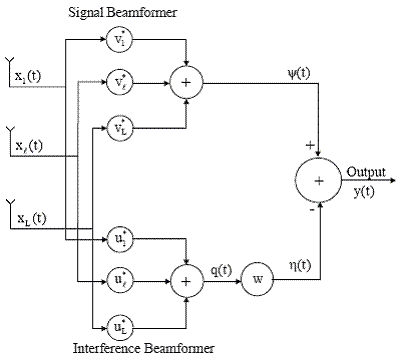
In this section, a processor with two beams referred to as the postbeamformer interference canceler (PIC) is examined in the presence of a look-direction signal of power PS, an interference of power PI, and uncorrelated noise of power σn^2.for the general beam space processor, the two-beam processor processes the signals derived from an antenna array by forming two beams using fixed beamforming weights, as shown in Figure 11. One beam, referred to as the signal beam, is formed to have a fixed response in the look direction. The processed output of the second beam, referred to as the interference beam, is subtracted from the output of the signal beam to form the output of the PIC.

Figure 11 : Post-beam former interference canceler structure.
Let L-dimensional complex vectors V and U represent the fixed weights of the signal beamformer and the interference beamformer, respectively. It follows from Figure 11 that the output ψ(t) of the signal beam and the output q(t) of the interference beam are, respectively, given by
| (6.43) | |
| and | |
| (6.44) |
| (6.45) | |
| For a given weight w, the mean output power P(w) of the PIC processor is given by | |
| (6.46) |
Optimal PIC
Let wˆ represent the complex weight of the interference channel of the PIC that minimizes the mean output power of the PIC for given beamformer weights V and U. This weight wˆ is referred to as the optimal weight, and the PIC with this weight is referred to as the optimal PIC. From the definition of the optimal weight, it follows that
 |
(6.47) |
| which along with (6.46), implies that | |
| (6.48) | |
| The mean output power of the optimal PIC is given by | |
| (6.49) |
| (6.50) |
This choice of beamformer weights for the signal beam ensures that the response of the signal beam in the signal direction is unity.
These three cases are: PIC with Conventional Interference Beamformer , PIC with Orthogonal Interference Beamformer , PIC with Improved Interference Beamformer
Back To Contents .